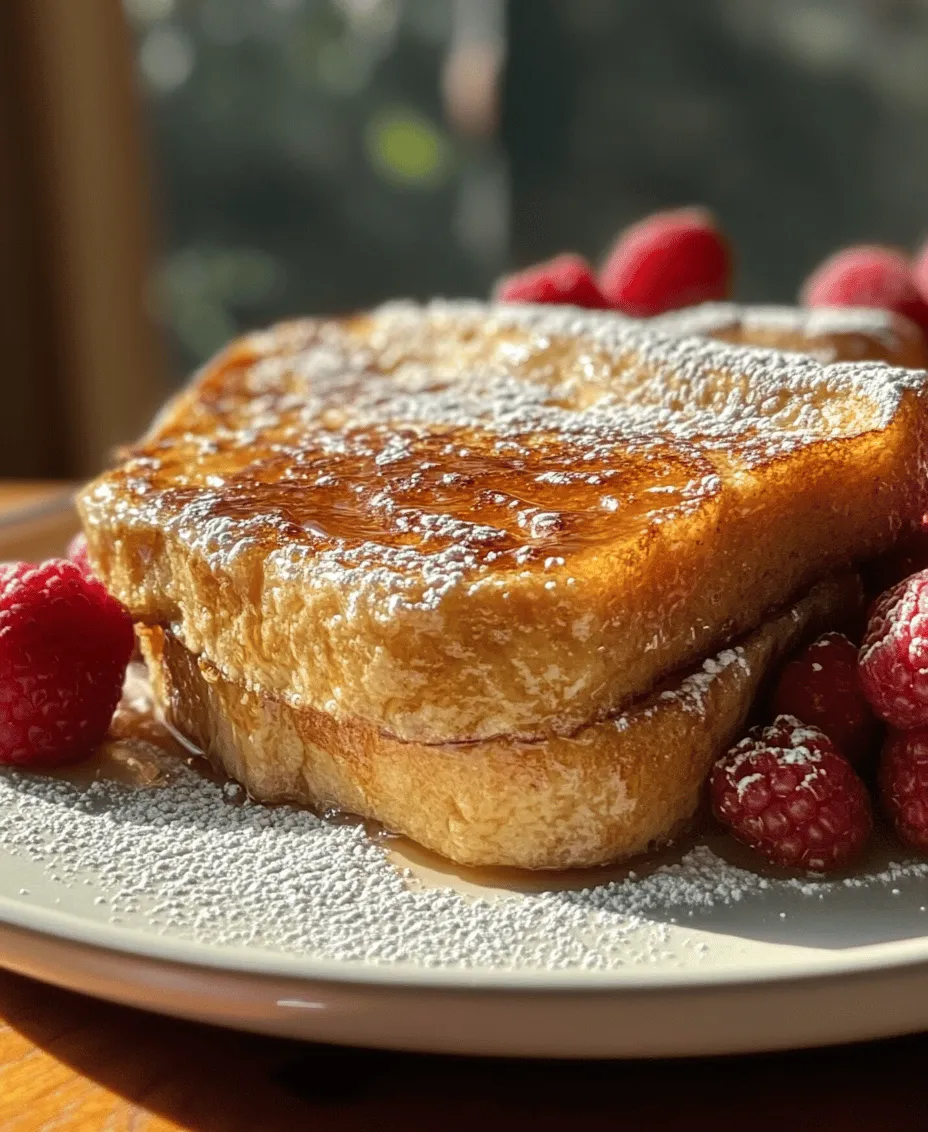Introduction
When it comes to breakfast or brunch, few dishes can rival the indulgence of crème brûlée French toast. This delightful dish combines the creamy, caramelized flavors of classic crème brûlée with the comforting texture of golden brown French toast. Imagine a rich custard soaked into thick slices of brioche bread, baked to perfection, and finished with a perfectly crisp sugar topping that crackles under the fork. This recipe not only tantalizes your taste buds but also offers a visually stunning presentation that will impress your guests.
One of the greatest appeals of overnight crème brûlée French toast is the convenience it provides for busy mornings or special gatherings. With a bit of preparation the night before, you can allow the flavors to meld and develop, ensuring that each bite is a delectable combination of sweetness and warmth. This dish is perfect for holiday brunches, lazy Sunday mornings, or any occasion where you want to treat yourself and your loved ones to something special without the stress of last-minute cooking.
The Allure of Overnight Crème Brûlée French Toast
Overnight crème brûlée French toast is a dessert-inspired twist on the traditional breakfast favorite. This creative concoction elevates the humble French toast into a luxurious experience, making it a standout choice on brunch menus and at festive gatherings. The combination of rich custard and the signature caramelized sugar topping mimics the experience of enjoying a classic crème brûlée while incorporating the comforting elements of breakfast.
The popularity of this dish can be attributed to its versatility and the sensory delight it brings. The creamy custard, made with eggs, milk, cream, and sugar, creates a luscious texture that complements the fluffy brioche bread. As it bakes, the top forms a beautiful golden crust that adds a delightful crunch, contrasting with the soft, tender interior. The infusion of vanilla and cinnamon enhances the flavor profile, making each bite a rich, aromatic experience.
This indulgent French toast is not only visually appealing, with its golden crust and glossy caramelized top, but it also delivers a symphony of flavors and textures that will leave a lasting impression. The dish is often garnished with fresh berries and a dusting of powdered sugar, adding a pop of color and freshness that balances the richness of the custard. Whether served at a festive brunch or a simple family breakfast, overnight crème brûlée French toast is bound to become a favorite.
Ingredients Breakdown
To create the perfect overnight crème brûlée French toast, you’ll need to gather a few essential ingredients. Each component plays a crucial role in achieving the desired texture and flavor, so it’s important to choose high-quality items for the best results.
Brioche Bread
Brioche bread is the star of this recipe, and for good reason. Its rich, buttery flavor and soft, airy texture make it ideal for soaking up the custard mixture. Brioche is a bit denser than standard bread, which allows it to hold up well during the soaking process without becoming too soggy. The sweetness of brioche also complements the caramel notes of the crème brûlée, making it the perfect base for this dish.
Eggs
Eggs are essential for creating a rich and creamy custard that binds the ingredients together. They add structure to the French toast while providing a luxurious mouthfeel. When whisked with the milk and cream, eggs help create the perfect custard consistency that will soak into the brioche and set during baking.
Whole Milk and Heavy Cream
The combination of whole milk and heavy cream is what gives this recipe its signature creaminess. Whole milk provides a lighter texture, while heavy cream adds richness and depth of flavor. Together, they create a decadent custard that enhances the overall experience of the dish.
Granulated and Brown Sugar
Both granulated and brown sugar are used in this recipe, each contributing its unique sweetness and flavor. Granulated sugar is perfect for sweetening the custard, while brown sugar adds a hint of caramel flavor that ties the dish together. When it comes time to caramelize the top, a sprinkle of granulated sugar will create that desired crunchy crust reminiscent of traditional crème brûlée.
Vanilla Extract and Cinnamon
Vanilla extract is a key ingredient that infuses the custard with warm, aromatic flavor. It pairs beautifully with the sweetness of the sugar and enhances the overall taste of the French toast. A touch of cinnamon adds an extra layer of flavor, bringing warmth and spice that complements the dish perfectly.
Salt
A pinch of salt is often overlooked in sweet recipes, but it plays a crucial role in balancing flavors. Salt enhances the sweetness of the sugar and adds depth to the custard, ensuring that the dish is well-rounded and satisfying.
Fresh Berries and Powdered Sugar
For the finishing touches, fresh berries such as strawberries, blueberries, or raspberries can be added as a garnish. They provide a burst of freshness and color that contrasts beautifully with the rich custard. A dusting of powdered sugar adds a final flourish, making the dish look as good as it tastes.
Preparation Steps with Detailed Instructions
Now that you have a comprehensive understanding of the ingredients, it’s time to dive into the preparation of your overnight crème brûlée French toast. Follow these detailed steps to ensure your dish is a resounding success.
Preparing the Baking Dish
Before you start mixing the custard, it’s important to prepare your baking dish. Choose a 9×13-inch casserole dish for this recipe, as it provides ample space for the brioche slices to soak in the custard.
1. Grease the Dish: Start by greasing the baking dish with butter or cooking spray. This will prevent the French toast from sticking and ensure easy serving once it’s baked.
2. Arrange the Brioche: Cut the brioche into thick slices, about 1-inch thick. Arrange the slices in the greased baking dish in a single layer, slightly overlapping if necessary. This allows the custard to soak evenly into each piece of bread.
Making the Custard
The custard is the heart of this recipe, providing the rich flavor and creamy texture that makes crème brûlée French toast so irresistible.
1. Whisk the Eggs: In a large mixing bowl, crack the eggs and whisk them together until they are well beaten. This will help incorporate air into the custard, resulting in a light and fluffy texture.
2. Combine Milk and Cream: In a separate measuring cup or bowl, combine the whole milk and heavy cream. Gradually pour this mixture into the beaten eggs while continuing to whisk. This ensures that the eggs do not cook when they come into contact with the warm milk.
3. Add Sugar and Flavorings: Once the milk and cream are fully incorporated, add the granulated sugar, brown sugar, vanilla extract, cinnamon, and salt to the mixture. Whisk until all the ingredients are well combined and the sugars have dissolved.
4. Soak the Brioche: Pour the custard mixture evenly over the arranged brioche slices in the baking dish. Gently press down on the bread with your hands to ensure that each slice is fully submerged in the custard. This step is crucial for achieving the perfect texture.
5. Cover and Refrigerate: Once the brioche is fully soaked, cover the baking dish with plastic wrap or aluminum foil. Place it in the refrigerator and allow it to soak overnight (or at least for 4 hours). This resting period lets the flavors meld and ensures that the custard fully penetrates the brioche.
By following these steps, you’ll set the foundation for a delicious and indulgent overnight crème brûlée French toast. Stay tuned for the next part, where we will explore the baking process and the final touches that will make this dish irresistible.

Tips for Achieving a Smooth Custard
Creating a smooth custard is crucial for the perfect Overnight Crème Brûlée French Toast. Begin by ensuring that all your ingredients, especially the eggs and milk, are at room temperature. This step helps them blend more seamlessly, preventing a lumpy texture. When whisking the custard, use a gentle hand to avoid incorporating too much air, which can lead to a foamy custard. Strain the mixture through a fine-mesh sieve before using it to eliminate any undissolved egg whites or lumps, ensuring a velvety consistency. For an added depth of flavor, infuse your milk with vanilla beans or spices beforehand, allowing it to cool before mixing it with the other ingredients.
Combining Bread and Custard
Once your custard is smooth and ready, it’s time to combine it with the bread. Use a sturdy, day-old bread like brioche or challah, as its texture allows for better custard absorption. Cut the bread into thick slices, about 1 to 1.5 inches, ensuring that they are uniform for even soaking. Place the bread slices in a large baking dish, arranging them snugly without overcrowding. This will help the custard soak evenly. Pour the custard mixture over the bread, ensuring every slice is generously coated. You may need to gently press down on the bread to encourage absorption, allowing the custard to seep into the bread effectively.
Technique for Ensuring Even Coating and Absorption
To guarantee even coating and absorption, consider flipping the bread slices halfway through soaking. This technique ensures that both sides are equally saturated with the custard, enhancing the flavor throughout. After flipping, cover the dish with plastic wrap or a lid and gently press down once more. This will create a bit of pressure that encourages the custard to penetrate the bread evenly. Allow the bread to sit in the custard at room temperature for about 30 minutes before refrigerating it overnight. This resting period allows the flavors to meld beautifully and the bread to absorb the custard thoroughly.
Covering and Refrigerating
Once you have combined the bread and custard, it’s essential to cover the dish tightly with plastic wrap or a lid. This step prevents the custard from absorbing any unwanted odors from the fridge and keeps it moist. Refrigerate the dish for at least 8 hours or overnight. The longer the bread soaks, the richer the flavor and texture will be. Overnight soaking allows the custard to work its magic, transforming ordinary bread into a decadent, custardy delight that is ready to be baked into perfection.
Discussion on the Soaking Time and Its Impact on Flavor and Texture
Soaking time significantly impacts the final dish’s flavor and texture. A shorter soaking time may result in bread that lacks the deep, custard-like consistency that characterizes crème brûlée French toast. Conversely, too long a soak can lead to overly mushy bread. The ideal soaking period is around 8 to 12 hours, allowing the custard to fully infuse the bread while maintaining its structural integrity. This balance creates a dish that is creamy and rich inside while still having a slight crust on the outside after baking.
Baking the Overnight French Toast
Preheating the Oven
Before you start baking, preheat your oven to 350°F (175°C). Preheating is a crucial step as it ensures that your French toast cooks evenly and thoroughly. A properly heated oven will help achieve that golden-brown crust while keeping the inside soft and custardy. If you have a convection oven, consider using that setting as it can help circulate the heat more efficiently, leading to even cooking.
Explanation of Temperature Settings and Their Significance
Baking at 350°F is ideal for this recipe as it allows the custard to set without overcooking. If the temperature is too low, the custard may not firm up properly, leading to a soggy texture. Conversely, a higher temperature can result in a burnt exterior while leaving the inside undercooked. Understanding your oven’s temperature settings is essential; using an oven thermometer can help ensure accuracy, especially if your oven tends to run hot or cold.
Baking Process
Once the oven is preheated, remove the dish from the refrigerator. Optionally, sprinkle a little sugar on top of the soaked bread slices if you plan to caramelize the top later. Place the baking dish in the oven and bake for 30 to 40 minutes, uncovered. During this time, keep an eye on the French toast; the custard should be set in the middle, and the top should be golden brown and slightly crispy. A good indicator of doneness is to insert a knife into the center; it should come out clean without any runny custard.
Detailed Instructions on Baking Duration and Visual Cues for Doneness
For optimal results, start checking the French toast at the 30-minute mark. If the top is nicely browned but the middle still seems a bit wobbly, reduce the oven temperature to 325°F (163°C) and continue baking. The total baking time may vary based on your oven and the depth of the custard; typically, a total of 35 to 45 minutes is ideal. Once it’s done, let it sit for about 10 minutes before serving. This resting period allows the custard to set further, making it easier to cut and serve.
Optional Caramelization Step
To achieve that signature crème brûlée topping, consider caramelizing the sugar on top of the baked French toast. After removing it from the oven and letting it cool slightly, sprinkle a thin, even layer of granulated sugar over the top. Using a culinary torch, carefully melt the sugar until it bubbles and turns a golden brown. If you don’t have a torch, you can place the dish under the broiler for a minute or two, watching it closely to prevent burning. The goal is to create a crunchy sugar crust that contrasts beautifully with the creamy custard underneath.
Serving Suggestions
Once your Overnight Crème Brûlée French Toast is baked and caramelized, it’s time to serve. For the best experience, enjoy it warm. Cut it into generous squares or rectangles and serve it on individual plates. Garnishing with a dusting of powdered sugar adds a beautiful touch, while fresh berries or slices of banana can enhance both the visual appeal and flavor profile.
Ideal Serving Temperature and Garnishing Options
The ideal serving temperature for this dish is warm, just enough for the caramelized sugar to retain its crunch. Garnish with a dollop of whipped cream and a sprinkle of fresh mint for added freshness. You can also serve it with a side of syrup for those who prefer a sweeter touch, or even a scoop of vanilla ice cream for a decadent dessert twist.
Pairing Recommendations for Beverages
Pair your Overnight Crème Brûlée French Toast with a hot beverage, such as a freshly brewed cup of coffee or tea. For a more festive touch, consider serving it alongside mimosas or a light sparkling wine. The acidity of the beverages beautifully complements the rich flavors of the French toast, balancing out the sweetness.
Suggestions for Additional Toppings
Feel free to get creative with additional toppings. A drizzle of warm maple syrup adds a classic touch, while caramel sauce can enhance the indulgence. Sliced almonds or pecans can provide a satisfying crunch, while a sprinkle of cinnamon or nutmeg can elevate the flavors further. The beauty of this dish lies in its versatility, allowing you to customize it to your liking.
Nutritional Information
To help you make informed choices, here’s a breakdown of the nutritional values per serving (based on a recipe serving 8):
– Calories: Approximately 350
– Total Fat: 18g
– Saturated Fat: 10g
– Cholesterol: 100mg
– Sodium: 300mg
– Total Carbohydrates: 42g
– Dietary Fiber: 1g
– Sugars: 15g
– Protein: 8g
Discussion on Dietary Considerations
When preparing this recipe, it’s essential to consider dietary needs. While delicious, it is rich in calories and sugar, making it more suitable for special occasions rather than everyday meals. For a lighter version, you can substitute whole milk with almond milk or use a sugar substitute for a lower-calorie option. Additionally, those with gluten sensitivities can opt for gluten-free bread varieties.
Conclusion
This Overnight Crème Brûlée French Toast is a delightful blend of two beloved dishes, providing an indulgent breakfast that feels special without overwhelming preparation. With its creamy custard, crispy caramel top, and customizable toppings, this dish is sure to impress at brunch gatherings or family breakfasts. The ease of preparation, particularly the overnight soaking method, makes it an ideal choice for busy mornings or celebrations.
Encouraging everyone to try this recipe is a call to experience the joy of combining classic desserts with traditional breakfast elements. The result is a dish that not only satisfies your sweet tooth but also brings loved ones together around the breakfast table, creating cherished memories with every bite.



